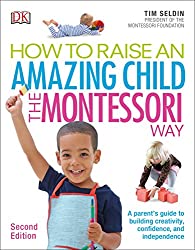Increase Your Enrollment in Montessori with Proven Sales Techniques
by Matt Bronsil, author of Before the Sandpaper Letters: Creating Phonological Awareness in the Montessori 3-6 Classroom

Even after being born into Montessori and over two decades of working in Montessori, I am often still stumped with the question, "What is Montessori?" For a long time, I have gotten this question from parents looking to enroll their child in my school. But to me, Montessori is the "normal" method of education and the idea of sitting in desks and listening to a teacher talk was always a strange concept to me, even as a child. I know a lot more goes into a traditional classroom than just a teacher talking and students sitting, but that's always how I imagined it growing up, and I bet that is how many adults still imagine it today when they think back on their education. But Montessori was such a huge part of my life that the question "What is Montessori?" often feels like if fish could talk and asked me, "What's it like getting oxygen from air instead of water?" Well...I don't know, Mr. Fish. It's just what I have always known. Same with Montessori...just what I have always known.

A fish and I discussing oxygen intake.
What I have learned to do is taking a certain sales approach to the parents interested in our school. Almost everyone has some idea that Montessori is different and most that come to our school are looking for something different from the normal school settings they keep seeing. If somebody says in an interview, "Sell me this pen," the absolute worst thing you can do is to start talking about the pen features. What you want to do first instead is to find out why the person would be in the market for a pen. Your Montessori school is the "pen" in this situation: find out why the parent is looking to enroll in a school and what they want or need from the school. This is the first step.
Step 1: Find Out What They Want
Begin by asking questions. The questions you ask should give you insight into what the child is like and what the parents think would best help the child. You can ask questions such as:
- Tell me about your child. Ask how old they are and what interests they have.
- How did you find our school?
- Have you looked at other schools? What did you like about them and what did you hope they did differently?
Be careful. You don't want to just throw these questions out there one after the other. You want to try to gather as much of that information through just a normal conversation. Honestly, the way to do this is to really not see this as a sales pitch. I genuinely ask these questions because I want to know more about the child so I know how I can help the child when they come to me. That reason should be your goal. You are not simply trying to enroll one more student in the classroom; your goal is to help as best you can any student that does come into the classroom. I think the biggest mistake people make is they change the focus to getting the enrollment, rather than finding out the needs of the parents and child.
Step 2: Before You Show the Classroom, Ask Permission to Show
There is an important, but subtle, difference between "Let me show you our classrom and point out what will help Mike" and asking, "Can I show you what I think will help Mike in the classroom?" By asking for permission to show the classroom, the parent feels much more invited into and involved in the decision making process. It puts them in charge of the decision rather than being told what you're doing next.
Now that you are showing the classroom is the time to work with all the information you got from the parents before. If the parent says their 3-year-old child has a strong interest in building blocks, point out the pink tower, broad stairs, and knobless cylinders. Explain how they are not meant for just building like regular blocks are, but developing the senses and compliment the toy building blocks at home. Explain how things tie together to the rest of the curriculum, like how the size of the smallest cube and the largest cube are similar to the size of the unit bead and 1000 cube in math and how easy it is to understand these ideas sensorially because they have the experience of the pink tower.
If the parent talked a lot about liking Montessori because of the curriculum for math and language, show those materials, but also put it in the perspective of how the curriculum and method is really focused on the development of the child, not just "learning math" or "learning how to read." Show how the various materials tie together to build up the concentration, fine motor skills, and mental organization to be able to visualize what is happening. Maybe even show more advanced lessons, like how to figure out square roots of 4-digit numbers with the stamp game and "wouldn't it be awesome if everyone learned math this way? Imagine how much easier it is once you can visualize the math rather than just trying to remember it rotely." Point out that you do have academics, but the academics are an important part of a whole system of development, so it prepares them with a stronger foundation for learning beyond preschool and kindergarten. I point that last line out because I have noticed parents who are mainly concerned with academics are thinking of how to prepare the child for school that comes after Montessori. You want to reassure them that they are getting a good education now that will help them now, but also prepare them for what is next. I know we tend to like to focus on the child now, but some people are future-minded. I don't know how many times I have been asked what a preschooler needs now to prepare them for Harvard. We have to respect that perspective, because it is coming from a question of wanting to provide the best for their child. So focusing on how we have a strong academic curriculum AND we prepare the child for the future learning opportunities is something that resonates with parents who focus on the academic aspects.
I love when a parent says they found us because someone they know recommended us. If there is already a connection to a parent in the school, you have to walk a fine professional line to talk about that child. I cannot speak about specific things, but I always like to include something about the child and one of their really positive aspects, but keep it general. "Shannon is such a great child to have in class. She really likes to try to make me laugh and she is so caring and helpful when a younger student feels sad or needs help." Or if a parent seems interested in a material that Shannon likes doing, "You mentioned Shannon's mom told you about our school. Shannon really likes that work. I do it with her a lot." Just small things that relate back to the connection that brought the parent to your school.
If they found us because they want to leave the other school and are just searching to see what is out there, this is also a great chance to probe into what the other school is like and what they think it is missing for their child. Don't get too detailed and people won't want to bad mouth the other school usually (though be ready for some stories as you go on through the years...). One of the biggest things I hear is the school or teachers did not communicate well with the parents. This is something we do well. We have a Line group for our classroom. (Line is a popular APP in Taiwan. I assume America still uses Skype? Or at least most people know what Skype is? It is basically a messaging app). That is for the parents, teachers, and our administrator to communicate regularly. In the group chat, we often post pictures of what is going on in the classroom, funny stories that happened throughout the day, news of upcoming events/holidays/outings, etc. Parents can also message me any time and I get back to them within a reasonable time frame. To me, I think (outside of an emergency), "reasonable" means "during working hours at some point," but I am usually able to answer outside of working hours. But I don't push myself on that. Just if I have an extra minute or whatever when I am just watching youtube videos, I will likely reply. Sometimes I don't until the next morning, though. ;-)
Step 3: Get the Enrollment

Creating a Sense of Urgency
I know what you're thinking when I use that phrase: PRESSURE. This is not what this is. I'm not pushing, "OK. Do it now or there will be an acoclypse." I do often, however, say something like, "We do have four spots open in our class and we often get a lot of people looking at the end (or beginning...whenever it is) of the year. Would you like Mike to come and be in one of those spots?" Subtly nod your head in the "yes" motion as well. This helps gear people to agree with you more.
There is a difference between "You need to take this spot now or it will be gone" vs. "This is how many spots we currently have left. Would you like your child to be in that spot?" If you did everything right, the answer to them wanting Mike to be in that spot will also be a yes, so the parent is inclined to say yes to that answer.
If They are Unsure/Need To Discuss It
It is understandable that most parents will want to talk over their decision outside of your presense. To combat this, barracade the doors and refuse to let them leave until they sign up. Ok. I am joking. Don't do that. Here is what I have done that helps. And feel free to use this exact line.
"I definitely agree with seeing all your options. To make sure you have a more information and a better feel for what options you have, would you like to have Mike come in for a free trial for a few mornings? Maybe just a couple hours in the morning, if you think he might not be ready for the whole morning yet? We can even have you come in with him sometime outside of class to have him look around to get used to the environment before he comes to try it out with other children."
Because what is one of the biggest fears of a parent? They are going to make a choice of a school, pay the tuition, the child starts the school, and the child absolutely hates the school, and the parents don't trust the teacher to work with them to fix the issues. You've just alieviated all those fears by offering this chance to come in and try it. You may still get a screaming child at drop off or one that has trouble getting settled, but prepare the parents for that ahead of time. You can even do a walk through with a dropoff plan you have set up when the child comes to visit before they start that trial. From there, it takes open and honest communication with the parent. Even if a crying child calms down right when the parent leaves, never state it that way to the parent. Rather say something like: "He was crying when he left and I'm sure he had a lot of emotions. He probably knew he would miss you, were unsure when you would come back, what everyone in the classroom is going to be like, and a hundred other things. He did eventually calm down and began to feel more comfortable."
What I find in these trial times is complete honesty is the key. Even if the child spends almost the entire morning crying, ackowledge it, but also talk about what you did to help the child. An example of something like this might be: "He did cry for quite a while. I first invited him to sit with me, but he did not want that, so I invited him to the couch in the reading area to sit down. He sat down and I wanted to sit with him, but he pushed me away. After about 20 minutes his crying slowed down and I asked one of our older students to go and check on him. He warmed up right away to her and they both began working on a puzzle together. I then showed Mike the pink tower, which he loved doing. I said we can try it again tomorrow and he is excited about it." People worry that if we say a child was crying, the parent won't bring them back. Ackowledge he was crying and say how he managed to handle it. I'll usually try to send that message to the parents before they pick up their child so they can also be calm. Sometimes calming the parents' worries is harder than calming the childs' worries.
Summary
- Gather information about the child and what the parent needs for their child's education. Most of this is done through questions.
- Ask permission to show the classroom. Focus on showing how your environment responds and fulfills the needs the parents expressed.
- Close the sale and get the enrollment. Provide the opportunity to enroll in a popular class that may soon fill up. Handle any hesitancy or uncertainty with a free trial.
Thanks for reading and be sure to share with others. And be sure to check out some of our amazon affiliate links below for some great Montessori books. If you want one of my books I wrote, take a look at my Amazon.com page. Good luck with your newly-enrolled students.
Matt Bronsil is the author of these posts. He can be contacted at MattBronsilMontessori@gmail.com. To contact him or sign up for updates to the site, visit the contact page.
<<< Back to the full article list <<<
Recommended Books




Montessori Second/Foreign Language Blogs

Learn Easily
Teahing Videos
Teaching Reading
Teaching Reading
Montessori's Different
Montessori is Different
EFL and Montessori
EFL and Montessori
Become a Teacher
Become a Montessori Teacher
Silent E
Silent E
Shining Pennies
Shining Pennies
